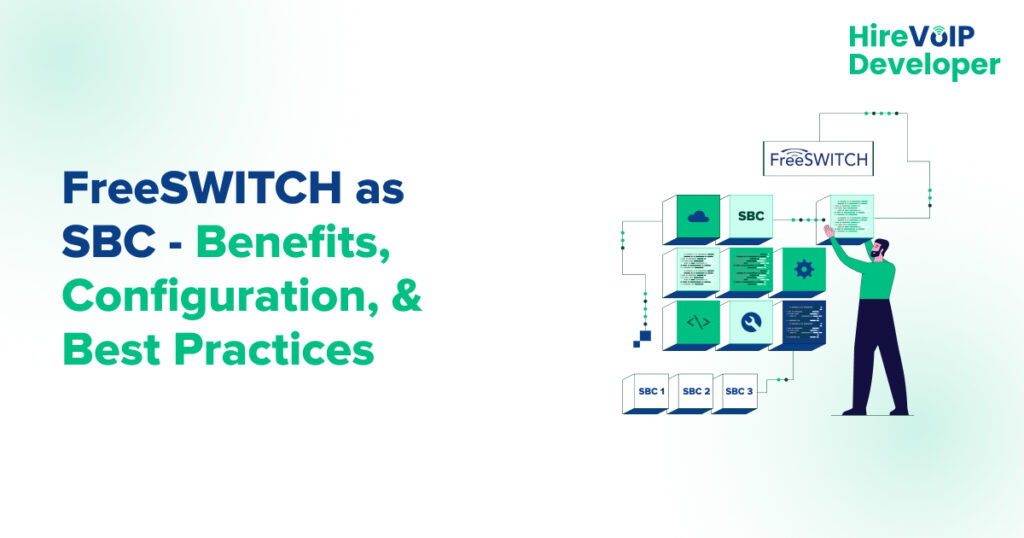📝 Blog Summary
The article highlights the power of using FreeSWITCH as an SBC, covering its key benefits, setup process, best practices, and practical insights. Topics include FreeSWITCH SBC setup, configuration steps, security features, SIP interoperability, and a helpful FAQ section for beginners and pros alike.
If you’ve been in the VoIP world for a while, you’ve probably heard the name FreeSWITCH. But what many people don’t realize is how powerful FreeSWITCH as an SBC (Session Border Controller) can be.
Yes, FreeSWITCH Solutions isn’t just a media server or softswitch – it can work as a super-capable SBC, too! So, if you’ve ever found yourself wondering, “Is FreeSWITCH an SBC?”, then buckle up – we’re about to dive into the how, why, and best practices behind turning FreeSWITCH into your go-to SBC solution.
🗝️ Key Highlights
- Step-by-step insights into using FreeSWITCH as an SBC, covering configuration, VoIP security, and key deployment benefits.
- Detailed explanation of FreeSWITCH SBC setup without code, perfect for beginners and IT teams planning a robust VoIP solution.
- Handy FAQ sections covering everything from making calls with FreeSWITCH to SBC use cases, SIP trunking, and real-world implementation tips.
What’s an SBC Anyway – and Why Should You Care?
An SBC (Session Border Controller) is like the security guard, gatekeeper, and traffic cop of your VoIP network all rolled into one. It manages voice traffic, shields your system from external threats, ensures NAT traversal, and even cleans up messy SIP messages between providers.
In short, if you’re dealing with real-time communication over the Internet, you need an SBC.
Now, here’s the cool part: FreeSWITCH can step up and take on this role incredibly well. With some configuration and tuning, it becomes a powerful open-source session border controller that’s both flexible and budget-friendly.
Is FreeSWITCH an SBC?
Absolutely! With the right configuration, Freeswitch as SBC can handle everything a traditional SBC does – and often, much more. It manages both signaling and media, supports NAT traversal, provides advanced routing, and adds layers of security. The flexibility it offers makes it a popular choice for VoIP providers and enterprises alike.
Plus, it’s open-source.
That means you’re not locked into expensive licenses, and you can customize your SBC to suit your exact needs. Not bad, right?
Why Use FreeSWITCH as an SBC?
So, why should you consider using FreeSWITCH as an SBC when there are plenty of commercial Session Border Controllers out there?
The answer boils down to three words: flexibility, cost, and control.
💡 Did You Know?
FreeSWITCH was originally created in 2006 by former Asterisk developers who wanted a more scalable and modular telephony engine – and it was literally built in a basement!
Talk about a glow-up from a garage project to a global VoIP powerhouse!
Let’s break it down.
1. It’s Open Source and Free
First and foremost, FreeSWITCH is open source. That means no hefty licensing fees, no vendor lock-in, and the freedom to customize it the way you want. In a world where many SBCs come with a steep price tag and limited flexibility, FreeSWITCH SBC stands out as a budget-friendly alternative that doesn’t skimp on features.
You can build a scalable SBC solution without worrying about per-channel licensing or extra fees just to unlock basic functionality. And that’s a big win for small service providers, startups, or even enterprise teams trying to stretch a tight budget.
2. Highly Customizable and Modular
Unlike black-box SBCs, FreeSWITCH is built with flexibility in mind. Want to rewrite SIP headers on the fly?
Route calls based on specific caller IDs? Limit calls per second for a given trunk? You can do all of that – easily.
The modular architecture of FreeSWITCH lets you add exactly what you need. Whether it’s transcoding, NAT traversal, or call recording, you can tailor your setup to your use case. That’s the power of using Freeswitch as SBC – you’re in the driver’s seat.
3. Robust Security Features
Security is a big deal in VoIP and FreeSWITCH takes it seriously. It supports encrypted signaling and media (TLS and SRTP), access control lists (ACLs), and real-time blacklisting tools like fail2ban.
This makes it easy to implement VoIP security FreeSWITCH practices that protect your system from SIP scanners, toll fraud, and unauthorized access. The beauty here is that you can fine-tune your security posture to match your exact needs, unlike commercial SBCs that often lock down configuration options.
4. Great NAT Traversal and Media Handling
We all know NAT can be a nightmare in SIP communications. But FreeSWITCH handles it like a pro. With features like ext-sip-ip and ext-rtp-ip, it simplifies NAT traversal and ensures reliable media flow – even across firewalls.
And since it can act as a media relay, it’s great at hiding internal IPs (topology hiding) and dealing with tricky network setups. So when you’re setting up a FreeSWITCH SBC config, you can rest assured that your calls will make it through, no matter the network conditions.
5. Protocol Normalization and Interoperability
Not all SIP implementations play nice together. FreeSWITCH acts as a translator between carriers, devices, and PBXs that speak slightly different “dialects” of SIP.
It can normalize SIP headers, convert codecs, and fix malformed messages. That makes it a fantastic SBC FreeSWITCH configuration example when you’re connecting dissimilar systems or troubleshooting SIP interoperability issues.
6. Proven in Production
FreeSWITCH is battle-tested. It’s been used in massive VoIP deployments worldwide – from telecom providers and call centers to conferencing platforms and enterprise solutions. So, using FreeSWITCH SBC setup in production is far from an experiment – it’s a trusted strategy.
And thanks to its strong community and active development, you’re never alone. Whether you’re fine-tuning your FreeSWITCH SBC setup guide or troubleshooting a config issue, there’s a community of pros (and tons of documentation) ready to help.
So again, if you’re still wondering, “Is FreeSWITCH an SBC?” – it’s not only possible, but it’s also a smart move for a lot of setups.
Secure Your VoIP Network with FreeSWITCH SBC! 🔐
FreeSWITCH SBC Setup – What’s Involved?
Okay, so you’re sold on the idea of using FreeSWITCH as SBC – awesome choice!
But now you might be wondering, “How do I actually set it up?” Don’t worry, the process isn’t as scary as it might seem. With a little planning and the right configuration steps, you’ll have a secure and efficient FreeSWITCH SBC setup in no time.
🤣 Fun Fact:
SBCs are like bouncers at a VoIP party – they check who’s coming in, who’s leaving, and make sure no one crashes the call!
Here’s a high-level overview of what’s typically involved when transforming FreeSWITCH into a reliable open-source session border controller.
1. Install and Prepare FreeSWITCH
First things first – you’ll need to install FreeSWITCH on a clean Linux server. Debian or Ubuntu are the go-to choices for most users, thanks to community support and ease of package management. You’ll want to include the core FreeSWITCH modules, along with SIP (sofia) support and whatever additional tools you need (like XML or Lua routing).
Once installed, test your basic installation to make sure everything’s running before moving on to SBC-specific configuration.
2. Configure SIP Profiles (Internal & External)
This is where the magic begins. Typically, you’ll create two SIP profiles:
- Internal Profile: Handles devices or systems inside your private network.
- External Profile: Interfaces with the outside world – carriers, trunks, remote endpoints.
These profiles are the heart of your FreeSWITCH SBC config. You’ll define how SIP signaling behaves, which ports to listen on, what IP addresses are exposed, and how NAT should be handled. This separation helps with both security and clarity, especially when managing complex call flows.
3. NAT Traversal and Media Relay
NAT can cause headaches in SIP, but FreeSWITCH is well-equipped to deal with it. You’ll need to configure external IP detection so that media (RTP) flows correctly between networks. This is crucial for avoiding one-way audio issues and making sure calls stay connected.
When used as an SBC, FreeSWITCH can also act as a media relay. This means it handles the media streams directly, allowing for features like media anchoring, topology hiding, and transcoding – features you’d expect from any solid SBC solution.
4. Set Up Call Routing and Dialplans
Once your SIP endpoints are connected, you’ll need to decide how calls are routed. This happens in the dialplan – FreeSWITCH’s powerful and flexible routing logic.
Here, you’ll define rules for:
- Inbound calls – From your carrier to internal users or services.
- Outbound calls – From your network to external SIP trunks.
- Fallbacks or failover – In case a trunk goes down or a route becomes unavailable.
Think of this as building the “rules of the road” for how your voice traffic flows through your SBC.
5. Implement Security and Access Control
Let’s not forget one of the key benefits of using Freeswitch as SBC: enhanced security. You’ll want to:
- Define Access Control Lists (ACLs) to allow only trusted IPs.
- Use authentication where needed (especially for outbound requests).
- Enable rate limiting or intrusion detection tools like fail2ban.
- Encrypt signaling and media with TLS and SRTP.
With these features, you’ll be practicing smart, real-world VoIP security FreeSWITCH style. It’s one of the most compelling reasons to adopt FreeSWITCH as your border controller.
6. Logging, Monitoring, and Debugging
Monitoring is a huge part of running a stable SBC. FreeSWITCH offers detailed logging and CLI tools to help you view SIP dialogs, check RTP streams, and track system performance. You can also integrate external tools like Homer or sngrep to visualize call flows and troubleshoot issues in real-time.
Proper logging and visibility ensure your FreeSWITCH SBC setup is easy to maintain and quick to debug when something goes sideways.
7. Test and Fine-Tune
Last but not least, test everything. Call in, call out, simulate NAT scenarios, try failover routes, and inspect the logs. The more you test up front, the smoother your deployment will go. Tuning parameters like timeouts, jitter buffer settings, and codec preferences also goes a long way toward optimizing call quality and reducing post-deployment headaches.
To sum it up, while setting up FreeSWITCH SBC may require a bit of initial effort, the payoff is huge: full control, enterprise-level features, and the flexibility to tailor your SBC exactly to your needs. This isn’t a plug-and-play black box – it’s a customizable powerhouse, and with this overview, you’re well on your way. Whether you’re building out your first FreeSWITCH SBC config or refining an existing one, this step-by-step approach will help ensure your system is stable, secure, and ready for production.
FreeSWITCH SBC Configuration Example (Conceptually Speaking)
Let’s imagine a scenario without diving into the actual code. Say you have a SIP trunk from a carrier and a set of internal SIP phones. You’d want FreeSWITCH to:
1. Accept Incoming Calls from the Carrier
When someone dials your business number, the call hits the SIP trunk and is passed along to your FreeSWITCH server. FreeSWITCH needs to recognize this call, verify it’s allowed (using ACLs), and then process it through a dialplan. This is the “entry point” into your system.
2. Route Incoming Calls to Internal SIP Phones
Once the call is accepted, FreeSWITCH should look at the dialed number and decide which internal user or phone should ring. This logic lives in your dialplan — it’s essentially the “traffic cop” that routes calls based on numbers, patterns, or even time of day.
3. Accept Outbound Calls from Your Internal Phones
Your internal users should be able to dial out as well, whether they’re calling clients, suppliers, or anyone else. When a SIP phone sends a call request to FreeSWITCH, it needs to authenticate (if configured) and be allowed by the access control list. Once cleared, FreeSWITCH again turns to the dialplan to figure out what to do with the call.
4. Forward Outbound Calls to the Carrier
If the number dialed is meant for the outside world, FreeSWITCH hands that call over to the SIP trunk. From there, your carrier takes over and sends it to the correct external number. Your SIP profile for the carrier defines how this call is formatted, what headers are sent, and which codecs are used.
This typical call flow is the essence of a SBC FreeSWITCH configuration example. The actual logic lives in dialplans, SIP profiles, and ACL rules. The beauty is in the control – you decide how everything flows. And if you’re just starting, no worries. There’s a thriving community, plenty of documentation, and tons of real-world use cases to learn from. Consider this your invitation to explore!
Best Practices for a Smooth FreeSWITCH SBC Setup
Now that you’re excited about turning FreeSWITCH into your SBC, let’s talk best practices to ensure success:
1. Keep It Updated
FreeSWITCH is an actively maintained open-source project. That means improvements, bug fixes, and — most importantly — security patches are rolled out regularly. Running the latest stable version ensures you’re protected against known vulnerabilities and have access to the newest features and performance enhancements.
Too often, outdated systems become easy targets for attackers simply because they were never patched. Make a habit of checking the FreeSWITCH changelog and update during scheduled maintenance windows. Use version control or staging servers to test upgrades before going live — just like any production software.
2. Monitor Traffic
VoIP isn’t just about sending and receiving calls — it’s also about visibility. You need to know what’s happening under the hood. Use tools like:
- Sngrep for SIP call visualization
- Homer (HEPic) for SIP capture and analysis
- Wireshark for packet-level inspection
- RTPEngine or rtpmonitor for media stream tracking
Real-time monitoring helps you spot anomalies quickly: failed registrations, unauthorized attempts, excessive traffic from one IP, or jitter and packet loss in RTP streams. The earlier you detect issues, the quicker you can prevent a security breach or fix quality-of-service problems.
Need Help Setting Up FreeSWITCH as an SBC? 💡
3. Restrict Access
FreeSWITCH should never be exposed wide open to the internet. Start with tight Access Control Lists (ACLs). Only allow known, trusted IP addresses — like your carrier and your internal subnets — to connect to SIP profiles. This stops the majority of malicious scanners and brute-force bots right at the edge.
If you’re hosting FreeSWITCH on a cloud server, combine ACLs with firewall rules (iptables, ufw, firewalld, etc.) and possibly fail2ban for brute-force protection. It’s far easier to prevent unauthorized access than to react once something goes wrong.
Lock it down early — security isn’t something you bolt on later.
4. Enable Encryption
With growing awareness around digital privacy, encryption is no longer optional. Ensure you’re using:
- TLS for SIP signaling
- SRTP for media (voice/video)
This protects sensitive information like phone numbers, call metadata, and even the voice content itself from eavesdropping. Carriers increasingly support encrypted connections, and FreeSWITCH natively supports both TLS and SRTP out of the box.
Make sure to install valid SSL certificates (let’s encrypt works great) and configure your SIP profiles to enforce TLS for external connections. Internally, if devices support it — use it. It’s better to be secure from end to end. Remember, a solid FreeSWITCH SBC setup guide is your best friend. Stick to documented procedures, test extensively, and don’t hesitate to ask the community when you’re stuck.
💡 Did You Know?
FreeSWITCH’s name comes from “Free,” as in open-source, and “Switch,” as in call switching – simple, but smart!
Final Thoughts
Using FreeSWITCH as SBC is one of the most cost-effective, flexible, and secure ways to manage your VoIP infrastructure. Whether you’re building a platform for a call center, VoIP provider, or enterprise communications, FreeSWITCH can easily adapt to your needs. From its powerful routing capabilities to strong encryption support, the FreeSWITCH SBC benefits are hard to ignore. And with real-world usage examples and growing community support, it’s never been easier to deploy an open source session border controller that just works.
So, if you’re on the fence and still wondering, “Who to choose?” Hire VoIP Developer can be your answer. It’s not only an SBC; it’s a flexible, secure, and customizable one. Whether you’re looking for a simple setup or a customized feature-rich configuration, there’s a place for FreeSWITCH in your toolkit.
Let’s keep the conversation going!


